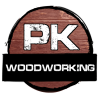So I just bought a brand new generic slider and am getting it all dialed in. One thing that I can not figure out is the tracking of the table being parallel to the top or blade. I have my magnetic dial indicator setup on the cast iron top and it is measuring against the edge of the sliding table. The dial indicator is fixed magnetically to the cast iron top and I am measuring the parallelness of the sliding table but not have any luck adjusting it to read within 10 thou forward and back. Is this the correct way to measure this? When the table goes forward it gets farther away and when it goes back it gets closer. I am driving myself nuts trying to get it to be straight throughout its travel forward and back. Any suggestions?




 Reply With Quote
Reply With Quote

